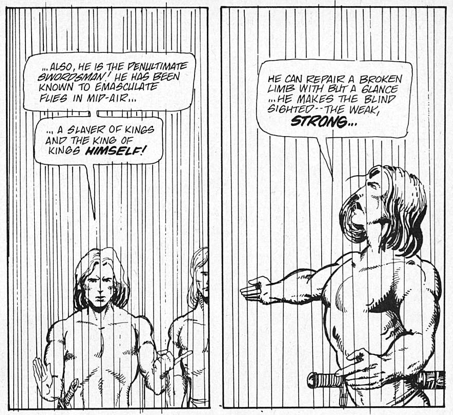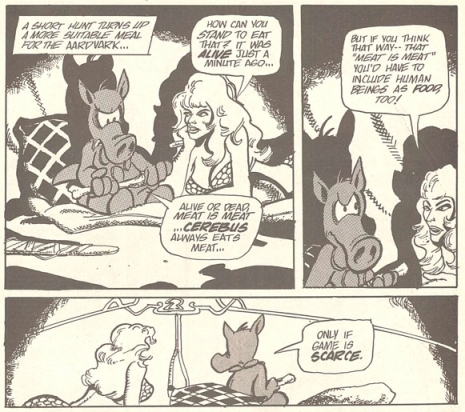My Year With Cerebus: Issues 7 & 8
By cambot3000 0 Comments
[Reposted from my blog 72 Pins]
Though I ultimately gave issue 6 its own post, I decided I could reclaim a little of my buffer zone by combining issues 7 and 8 today. However, I’m not simply forcing two unrelated issues into a single post. The events of Cerebus 6-8 are the closest thing to a multi-part story arc so far in the series, and at least in this case spreading the discussion of them over multiple posts feels more arbitrary than combining them.

Cerebus #7 almost reads like a recap of the series’s major themes so far. Cerebus travels to the Temple of the Black Sun, whose treasures he learned about from Jaka in the previous issue. Along the way, he runs into Elrod again, and drags him along in the vain hope of keeping him quiet
Meanwhile, the Black Sun priest Mit has hatched a plan to disguise himself as “one of the revered nameless ones”, who just happens to look like Cerebus. There’s no mention of whether this is the same god worshiped by the Pigts (whose idol Cerebus destroyed in issue 5), or whether Dave Sim just found the notion of aardvark-shaped gods really funny.
Of course Elrod and Cerebus get separated, allowing for some fun with Elrod mistaking the disguised priest for the real Cerebus. Meanwhile, in a scene that strongly recalls the climax of issue 2, Cerebus once again finds himself facing off against a monstrous enemy (this time a giant spider rather than a succubus) that tries, unsuccessfully, to find his soul. And once again, he finds himself saved by a mostly unexplained deus ex machina, once again leaving us to wonder if this is all going to mean something at some point in the future.

We pick up in Cerebus #8 with Cerebus hallucinating (another callback, to issues 1 and 6) that he is still fighting the giant spider underneath the Temple of the Black Sun. However, we quickly learn that he has been captured by the Conniptin army, who are desperate and on the verge of revolting against their supposed leader, a foppish prince suffering from cocaine-induced delusions of grandeur.If the recursive nature of Cerebus up to this point weren’t already clear, these two issues would make it so. I mentioned all the way back in my post on Cerebus #2 that it felt like a “do-over” of the first issue, a way to try out the same themes but with a slightly different tone. There’s a lot of that in 6-8, as well, so much so that it actually feels like it should be the ending of Cerebus’s story.
In a way, I suppose it is. Issue 8 looks like the transition from the self-contained stories of the first few issue to the longer form story arcs that eventually take over the series, with the Conniptin general trying to persuade Cerebus to lead their military campaign until such time as the prince can safely be assassinated, and Cerebus can be installed as the new Conniptin emperor.
The political intrigue here is well done, and has me really looking forward to reading the next few issues. However, I remain just as fascinated by the treatment of religion in these early stories, especially the recurring theme of humans (or aardvarks) as gods. Bran Mak Mufin in issue 5, Mit in issue 7, and the Conniptin prince in issue 8 are, to varying degrees, comfortable with being deified by their peers or followers. However, each has faced some sort of punishment for their presumptions. Cerebus rejected the Pigts’ religion and destroyed their idol; Mit was spared the destruction of the other Black Sun priests, but forced to travel with Elrod; and the Conniptin prince faces disgrace and assassination for his ridiculous behavior and self-deifying pronouncements.
There’s an undercurrent there that could just be a reliable storytelling mechanic, a way to portray the largely amoral Cerebus as a hero by giving him a relatively down-to-earth perspective on himself and the world; or it could be a hint that the ultra-conservative religious beliefs that Dave Sim eventually embraced were always hiding just below the surface, manifesting themselves in the recurring image of Cerebus as a fuzzy Yahweh, destroying would-be idols wherever they arise.
While I lean toward the former explanation (for now), I don’t think speculation on the latter is completely misguided.















Log in to comment